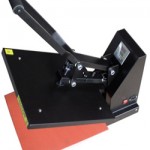Silk screen printing is one of the most used and the oldest form of making t-shirts. There are stories and pictures dating back to the 900s about how its origins. It’s considered an art form in Asia and has evolved into America’s classic way to make t-shirts. The basic process of silk screening involves paint or ink being forced through a mesh screen with a stencil with a tool called a squeegee. Silk screening traditionally used screens made of woven silk stretched over a wooden frame. Now, the mesh screens are typically made of polyester. Because polyester fibers are so smooth, they have to be roughed up so the paint and ink will stick. Then, it’s stretched over a steel aluminum frame to prevent rusting. There are some artists that prefer using natural fibers for silk screening. The expense of silk makes it impractical for most. So, some use cotton to make the mesh screens.
Silk screening used to mean hand cutting a stencil and gluing it to a screen. This had to be repeated for every color involved in a design and for every change needed like a different name on different shirts. It was a time consuming process. Now, designs can be printed from a computer. A thermofax stencil is the popular choice for printers. The image is fed through a machine that burns away the image areas for the stencil. Then, it’s ready for ink and paint to pass through.
Inks and paints key to making your t-shirts look their best. It’s a real chemistry experiment for t-shirt makers to coordinate the right ink thickness and the right screen size. It all depends on the level of detail each design requires. If the ink is too thin, it will run and your image will not be clear and defined. If the ink is too thick, it will not easily press through the screen.
Squeegees are very important to the silk screening process. They are similar to the tool you use to clean your windshield at the gas station. Squeegees force the ink and paint through the stencils. Typically, they are made of rubber, plastic or polyurethane depending on what type of ink is used.
The advantage of using silk screening is you can do it on any color t-shirt and any fabric blend. You’ll want to wash your shirts gently for the design to last longer. It’s traditionally an easy and relatively inexpensive way to make large batches of professional looking matching t-shirts. That’s if you have the pros do it for you. There are silk screening kits made just for consumers to give it a try at home. You can find them at craft stores and online. Keep in mind that it’s time consuming to make the stencils and screens for every color you want to use. And, all the ink makes it a messy process. But, trying it on your own might be just the kind of project you and your family have in mind for a creative day.
If you are looking for an easier way to create a t-shirt you may want to consider designing a t-shirt using our tools and we can print it using our advanced direct-to-garment printing method.

 You remember iron-on patches. That same low-tech method our mothers and grandmothers used to do a quick repair on our jeans is still one of the most popular ways to put images on t-shirts, but new technology is making it easier to make your own designs. Instead of making your first stop the fabric or craft store, head to the computer or office supply store. There you’ll find that t-shirt making is going high tech. New printers, transfer paper, inks, and computer programs are making designing and printing your own t-shirts at home easier than ever. Start with the right transfer paper for your printer. Check the package and be sure it’s compatible. The pros say it’s easier to transfer images to light colored shirts. If you are planning on using a dark t-shirt, there is paper specifically designed for those colors.
You remember iron-on patches. That same low-tech method our mothers and grandmothers used to do a quick repair on our jeans is still one of the most popular ways to put images on t-shirts, but new technology is making it easier to make your own designs. Instead of making your first stop the fabric or craft store, head to the computer or office supply store. There you’ll find that t-shirt making is going high tech. New printers, transfer paper, inks, and computer programs are making designing and printing your own t-shirts at home easier than ever. Start with the right transfer paper for your printer. Check the package and be sure it’s compatible. The pros say it’s easier to transfer images to light colored shirts. If you are planning on using a dark t-shirt, there is paper specifically designed for those colors.